Why we care about Accessibility
Recently, we got together as a company to talk about the subject of accessibility in web design and development. Our goal was to discuss how practises are evolving, and how we might improve our own processes in this area. Accessibility is something we take seriously and get passionate about because it represents value for everyone – for brands, and customers of all abilities.
In the lead up to this meeting, a few of us went off and researched the subject. And, in doing so, realised how many articles were out there ‘pitching’ accessible design and development practises with an ableist point of view – “digital accessibility helps able bodies too”. It’s true. But, it’s not the whole point.
So, what is the point? Well, yes, there are undeniable positives for everyone when you employ accessible practise. Captioning can be equally as useful for someone in a noisy environment as it is for the hearing impaired; or, the size of button interactions affect someone with a motor impairment as much as someone bumping around on a tram. There are countless examples of the overlap between accessibility and general usability, and as many articles pointing them out.
But, when you consider that 1 in 5 Australians are living with some form of disability – be it visual, hearing, mobility or cognitive in nature – then the argument of inclusion (overlap or not) should be just as strong, if not enough in itself. The acronym ‘SUX’, which stands for ‘some user experience’, is a play on UX (user experience) and its core intentions. When UX design fails to take into account all user experiences it ‘sux’ for those it excludes. In Australia alone that’s approximately 4 million people.

Why you should too
Because of Covid-19 we’re interacting in the digital world more than ever before. The idea of ducking out to the shops or an appointment exists in what seems like a different reality – even those who aren’t mitigating risk at home still contend with masks, sanitiser, and social distance. The incentive to switch to an online alternative is high; sometimes even enforced.
Older Australians, too, who may not identify as disabled but have age-related impairments and the lowest rates of digital literacy, are heading online as a matter of necessity. Platforms with accessibility and usability features are proving themselves, converting new audiences and customers with positive experiences.
In the retail space, a brand that demonstrates caring about inclusion wins fans of those who benefit from accessible functionality, and the growing many who shop with their values. And, as a business incentive, an accessible website boosts your SEO ranking.
While COVID-19 won’t go on forever, it has made brands and organisations realise the importance of their digital spaces – that’s something that will last for the foreseeable future.

